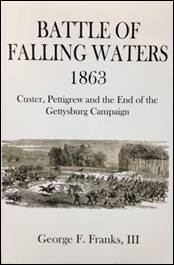
George F. Franks III
Createspace Publishing 118 pages
ISBN: 9781484138373
Image courtesy of inthepanhandle.com
George F. Franks III, has delivered something different than previous Gettysburg historians: he has written more than a few paragraphs about the encounter at Falling Waters at the end of the campaign. While the battle was a small engagement in the aftermath of one of the largest battles in the war, it truly is the end of the campaign. Franks gives due attention to the battle, but does he give enough attention to it?
George F. Franks III has spent the past ten years writing this account of the battle while delving into firsthand accounts, photographs and has even uses maps and drawings from his own collection for this book. He studied American History at both the U.S. Naval Academy and the University of Pittsburg and is the former president of the Capitol Hill Civil War Round Table along with being a member of the Hagerstown Civil War Round Table and with many other affiliations of military history.
In 2007, Franks published an article about the Battle of Falling Waters and because of that, he spent six years writing this book. The narrative he presents in this book is flowing and easy to follow but there is one thing which is desired in the realm of historical narrative. He separates the primary sources from the narrative and gives the reader an opportunity to read those accounts without his descriptions. This is purely a preference of reading which Franks has given us. While the narrative is flowing, there is a wonder if there is enough narrative to cover this pivotal moment of the campaign. One of the greatest parts of the book is the death of General Pettigrew. To gain a clear idea of what happened to the most intellectual man in the Confederacy during the American Civil War gives the reader closure as to what happened after Longstreet’s Assault also known as Pickett’s Charge. Franks also presents more of a Confederate view on the battle and the bibliography boasts more primary sources from Confederate writers than Union writers. This gives the work a one sided feeling throughout and has the style of modern “Lost Cause” historians. During the Battle of Falling Waters, Franks makes the Union cavalry out to be a harassing force instead of fighting force.
The Battle of Falling Waters, however, is worth reading for the most avid Gettysburg historian. Besides being treated to a page of history as many other Gettysburg works dedicate itself, Franks has given us a book filled with both narrative and primary sources. The best part of the work is the final chapter which describes the battlefield today. Being a smaller battle in the larger Gettysburg Campaign, the field can get lost, but with Franks’ directions, it should be an easy find for anyone. In conclusion, The Battle of Falling Waters leaves much to be desired in the realm of the narrative and the details of battle, but it is a good book for those not as familiar with the engagement.
 RSS Feed
RSS Feed
